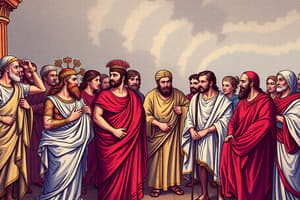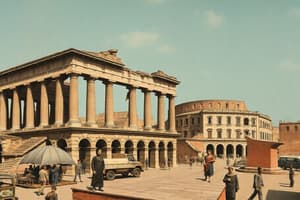Podcast
Questions and Answers
The Roman Republic's government structure incorporated which principle that is also fundamental to modern democracies?
The Roman Republic's government structure incorporated which principle that is also fundamental to modern democracies?
- Direct democracy with citizen assemblies.
- A hereditary monarchy advised by a council of nobles.
- Separation of powers among different branches. (correct)
- Rule by a philosopher-king selected through merit.
How did the Punic Wars MOST significantly contribute to Rome's transformation from a regional power to a dominant force in the Mediterranean?
How did the Punic Wars MOST significantly contribute to Rome's transformation from a regional power to a dominant force in the Mediterranean?
- By securing control over key trade routes and resources after defeating Carthage. (correct)
- By establishing alliances with powerful kingdoms in North Africa.
- By demonstrating Rome's naval superiority and technological innovation.
- By fostering a period of prolonged peace and economic prosperity within Rome.
Which factor MOST contributed to the social unrest and eventual decline of the Roman Republic?
Which factor MOST contributed to the social unrest and eventual decline of the Roman Republic?
- The expansion of the empire led to influx of wealth which was evenly distributed among citizens.
- The widespread adoption of democratic reforms that distributed power to commoners, leading to political gridlock .
- The increasing gap between the wealthy patricians and the impoverished plebeians. (correct)
- The Roman's success in maintaining peace and stability across all its territories.
How did Julius Caesar's rule MOST significantly mark a turning point in the history of Rome?
How did Julius Caesar's rule MOST significantly mark a turning point in the history of Rome?
What was the MOST significant impact of the Pax Romana on the Roman Empire?
What was the MOST significant impact of the Pax Romana on the Roman Empire?
Which statement BEST describes the role of slavery in the Roman economy?
Which statement BEST describes the role of slavery in the Roman economy?
How did Roman religion MOST influence Roman society and culture?
How did Roman religion MOST influence Roman society and culture?
How did Roman engineering achievements, such as aqueducts and roads, MOST contribute to the growth and stability of the empire?
How did Roman engineering achievements, such as aqueducts and roads, MOST contribute to the growth and stability of the empire?
What was the lasting significance of the Twelve Tables in Roman history?
What was the lasting significance of the Twelve Tables in Roman history?
Which combination of factors BEST explains the fall of the Western Roman Empire?
Which combination of factors BEST explains the fall of the Western Roman Empire?
Flashcards
Romulus and Remus
Romulus and Remus
Legendary founders of Rome, raised by a she-wolf.
Patricians
Patricians
Wealthy, elite class in ancient Rome, holding high government positions.
Plebeians
Plebeians
Common people of Rome, including farmers and workers, forming the majority.
Servi
Servi
Signup and view all the flashcards
Jupiter
Jupiter
Signup and view all the flashcards
Juno
Juno
Signup and view all the flashcards
Neptune
Neptune
Signup and view all the flashcards
Mars
Mars
Signup and view all the flashcards
Venus
Venus
Signup and view all the flashcards
The Twelve Tables
The Twelve Tables
Signup and view all the flashcards
Study Notes
- Rome is located on a peninsula in Europe
- Natural defenses surround Rome, including the Adriatic Sea, Mediterranean Sea, Tyrrhenian Sea, and the Alps
- Roman civilization began near the Tiber River
History of Rome
- The myth of Romulus and Remus is at the beginning of Rome's history; they were raised by a she-wolf
- Romulus was the first king of Rome, and the city was named after him
- Rome was initially ruled by Etruscans
- A revolution overthrew the Etruscans, and Rome became a republic
Social Classes
- Patricians: Wealthy, elite class, descendants of Romulus, held high government positions
- Plebeians: Common people, including farmers and workers, made up the majority of the population
- Servi: Slaves, the lowest class, often captured in war or enslaved due to debt
Religion of Rome
- Romans were polytheistic, borrowing many gods from Greek mythology
- Jupiter (Zeus): King of the gods
- Juno (Hera): Goddess of marriage
- Neptune (Poseidon): God of the sea
- Mars (Ares): God of war
- Venus (Aphrodite): Goddess of love
Roman Government
- Rome was a republic
- Three branches of government: legislative (Senate), executive (consuls), and judicial (judges)
- The Twelve Tables were the first written laws
Roman Economy
- Agriculture, trade, and slavery played key roles in Rome's economy
- The Mediterranean Sea facilitated trade
- Slaves provided labor for various industries
Technology
- Romans built aqueducts to transport water
- Weapons like ballistae were used for warfare
Writing System
- Romans used the Latin alphabet, which was based on the Greek alphabet
- Roman numerals were developed
Expansion of the Roman Republic
- Rome’s desire for power led to its expansion across the Mediterranean
- They defeated the Etruscans, Greeks, and Carthaginians
- The Punic Wars were key to Rome’s rise
Punic Wars
- First Punic War: Rome defeated Carthage and gained control of Sicily
- Second Punic War: Hannibal of Carthage invaded Italy, but Rome ultimately won at the Battle of Zama
- Third Punic War: Rome destroyed Carthage in 146 BCE
Civil War and Reforms
- The Roman Republic faced internal struggles, including class conflict and power struggles among generals
- The Gracchi brothers attempted land reforms but were killed
- Julius Caesar’s rise marked the end of the republic
Julius Caesar
- Caesar became dictator, made reforms, and expanded Rome’s territory
- His assassination in 44 BCE led to further instability
The Roman Empire
- After Caesar’s death, his successors, Octavian (Augustus), Mark Antony, and Lepidus, formed the Second Triumvirate
- Augustus became the first emperor, marking the start of the Roman Empire
Pax Romana
- The Roman Empire experienced a period of peace and prosperity under emperors like Augustus, Trajan, and Hadrian
- The empire declined after Marcus Aurelius’s death, leading to the end of the Pax Romana
Fall of the Western Roman Empire
- The Western Roman Empire eventually fell in 476 CE, marking the end of ancient Rome
Studying That Suits You
Use AI to generate personalized quizzes and flashcards to suit your learning preferences.




